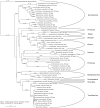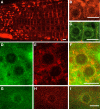The GIP gamma-tubulin complex-associated proteins are involved in nuclear architecture in Arabidopsis thaliana
- PMID: 24348487
- PMCID: PMC3842039
- DOI: 10.3389/fpls.2013.00480
The GIP gamma-tubulin complex-associated proteins are involved in nuclear architecture in Arabidopsis thaliana
Abstract
During interphase, the microtubular cytoskeleton of cycling plant cells is organized in both cortical and perinuclear arrays. Perinuclear microtubules (MTs) are nucleated from γ-Tubulin Complexes (γ-TuCs) located at the surface of the nucleus. The molecular mechanisms of γ-TuC association to the nuclear envelope (NE) are currently unknown. The γ-TuC Protein 3 (GCP3)-Interacting Protein 1 (GIP1) is the smallest γ-TuC component identified so far. AtGIP1 and its homologous protein AtGIP2 participate in the localization of active γ-TuCs at interphasic and mitotic MT nucleation sites. Arabidopsis gip1gip2 mutants are impaired in establishing a fully functional mitotic spindle and exhibit severe developmental defects. In this study, gip1gip2 knock down mutants were further characterized at the cellular level. In addition to defects in both the localization of γ-TuC core proteins and MT fiber robustness, gip1gip2 mutants exhibited a severe alteration of the nuclear shape associated with an abnormal distribution of the nuclear pore complexes. Simultaneously, they showed a misorganization of the inner nuclear membrane protein AtSUN1. Furthermore, AtGIP1 was identified as an interacting partner of AtTSA1 which was detected, like the AtGIP proteins, at the NE. These results provide the first evidence for the involvement of a γ-TuC component in both nuclear shaping and NE organization. Functional hypotheses are discussed in order to propose a model for a GIP-dependent nucleo-cytoplasmic continuum.
Keywords: Arabidopsis thaliana; AtGIP1/MOZART1; AtTSA1; gamma-tubulin complex; nuclear envelope.
Figures







Similar articles
-
The GCP3-interacting proteins GIP1 and GIP2 are required for γ-tubulin complex protein localization, spindle integrity, and chromosomal stability.Plant Cell. 2012 Mar;24(3):1171-87. doi: 10.1105/tpc.111.094904. Epub 2012 Mar 16. Plant Cell. 2012. PMID: 22427335 Free PMC article.
-
GIP/MZT1 proteins orchestrate nuclear shaping.Front Plant Sci. 2014 Feb 7;5:29. doi: 10.3389/fpls.2014.00029. eCollection 2014. Front Plant Sci. 2014. PMID: 24570680 Free PMC article. Review.
-
Arabidopsis GCP3-interacting protein 1/MOZART 1 is an integral component of the γ-tubulin-containing microtubule nucleating complex.Plant J. 2012 Jul;71(2):216-25. doi: 10.1111/j.1365-313X.2012.04988.x. Epub 2012 May 14. Plant J. 2012. PMID: 22404201
-
Corrigendum: The GIP Gamma-Tubulin Complex-Associated Proteins are Involved in Nuclear Architecture in Arabidopsis Thaliana.Front Plant Sci. 2020 Sep 11;11:589954. doi: 10.3389/fpls.2020.589954. eCollection 2020. Front Plant Sci. 2020. PMID: 33049005 Free PMC article.
-
Targeting of γ-tubulin complexes to microtubule organizing centers: conservation and divergence.Trends Cell Biol. 2015 May;25(5):296-307. doi: 10.1016/j.tcb.2014.12.002. Epub 2014 Dec 24. Trends Cell Biol. 2015. PMID: 25544667 Review.
Cited by
-
Highlight on the dynamic organization of the nucleus.Nucleus. 2017 Jan 2;8(1):2-10. doi: 10.1080/19491034.2016.1243634. Epub 2016 Oct 7. Nucleus. 2017. PMID: 27715428 Free PMC article. Review.
-
Cell-cycle dependent phosphorylation of yeast pericentrin regulates γ-TuSC-mediated microtubule nucleation.Elife. 2014 Apr 30;3:e02208. doi: 10.7554/eLife.02208. Elife. 2014. PMID: 24842996 Free PMC article.
-
GIP1 and GIP2 Contribute to the Maintenance of Genome Stability at the Nuclear Periphery.Front Plant Sci. 2022 Jan 27;12:804928. doi: 10.3389/fpls.2021.804928. eCollection 2021. Front Plant Sci. 2022. PMID: 35154196 Free PMC article.
-
Arabidopsis MZT1 homologs GIP1 and GIP2 are essential for centromere architecture.Proc Natl Acad Sci U S A. 2015 Jul 14;112(28):8656-60. doi: 10.1073/pnas.1506351112. Epub 2015 Jun 29. Proc Natl Acad Sci U S A. 2015. PMID: 26124146 Free PMC article.
-
The tethering of chromatin to the nuclear envelope supports nuclear mechanics.Nat Commun. 2015 Jun 15;6:7159. doi: 10.1038/ncomms8159. Nat Commun. 2015. PMID: 26074052 Free PMC article.
References
-
- Bajer A., Mole-Bajer J. (1969). Formation of spindle fibers, kinetochore orientation, and behavior of the nuclear envelope during mitosis in endosperm. Chromosoma 27, 448–484 10.1007/BF00325682 - DOI
-
- Ciska M., Moreno Diaz de la Espina S. (2013). NMCP/LINC proteins: putative lamin analogs in plants? Plant signal. Behav. 8 Available online at: http://www.ncbi.nlm.nih.gov/pubmed/24128696 10.4161/psb.26669 - DOI - PMC - PubMed
LinkOut - more resources
Full Text Sources
Other Literature Sources
Molecular Biology Databases
Research Materials

